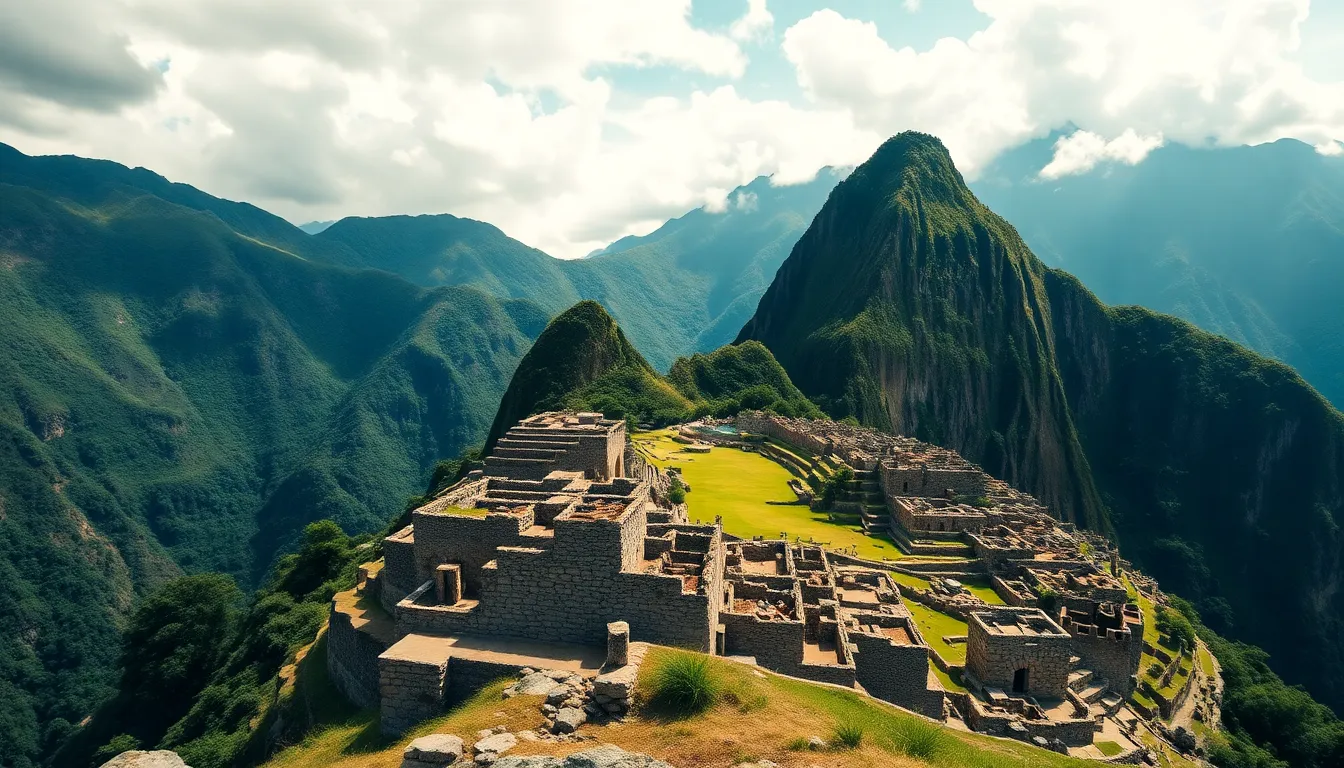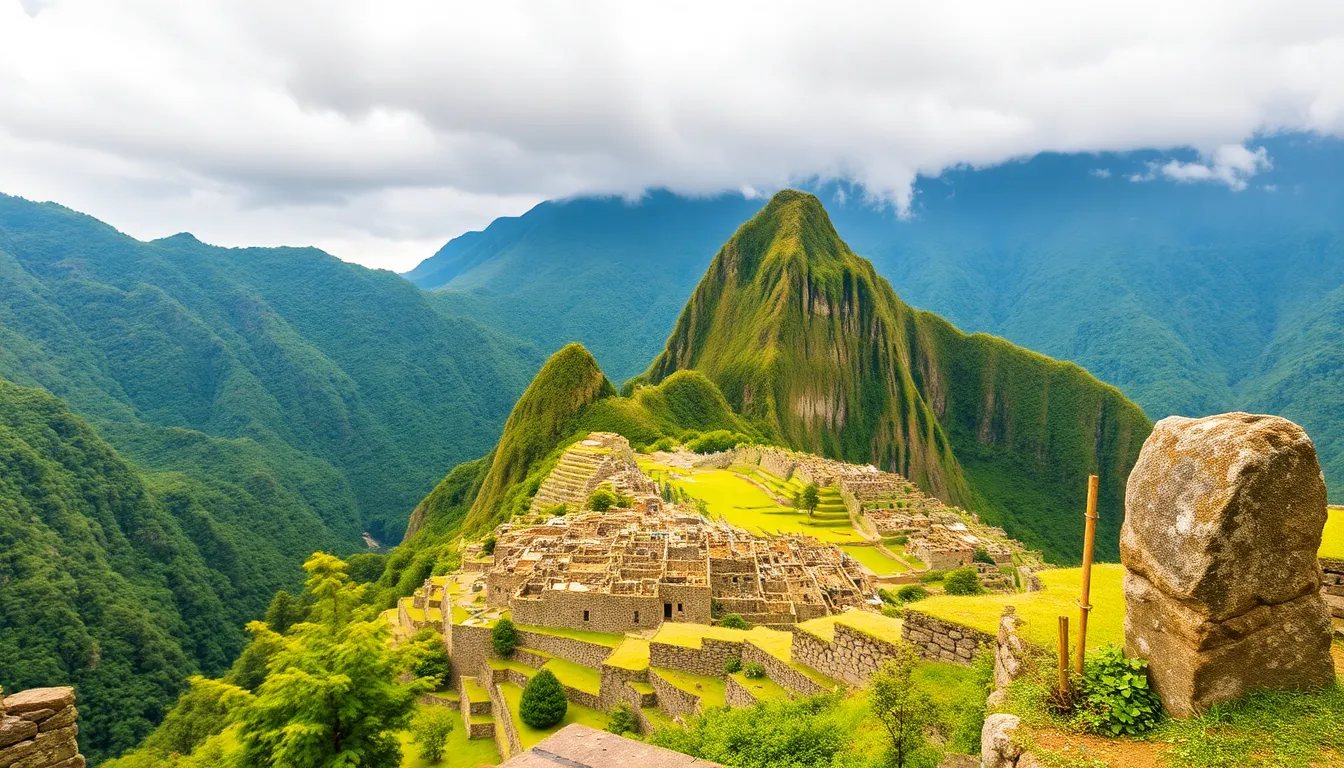Nestled high in the Andes Mountains, Machu Picchu is a breathtaking marvel that leaves travelers awestruck. But before you pack your bags and set off on an adventure, there’s one burning question that needs answering: what country is this iconic site in? Spoiler alert: it’s not in your backyard!
Table of Contents
ToggleOverview of Machu Picchu
Machu Picchu, often referred to as the “Lost City of the Incas,” resides in Peru’s Andes Mountains. Built in the 15th century, this UNESCO World Heritage Site represents Inca civilization’s architectural and agricultural innovations. Its elevation of approximately 7,970 feet (2,430 meters) above sea level contributes to its stunning panoramic views and diverse ecosystems.
Visitors encounter terraced fields that demonstrate advanced farming techniques. They can explore religious sites, including temples and altars, reflecting the spiritual significance the Incas placed on this location. The Intihuatana stone, believed to be a ritual stone associated with astronomy, stands as a centerpiece of the site.
Accessing Machu Picchu includes a scenic train journey or a challenging hike along the Inca Trail. Travelers often arrive at Aguas Calientes, the nearest town, before ascending the mountain. The combination of natural beauty and historical intrigue attracts millions each year, making it one of Peru’s top tourist destinations.
Significant archaeological research continues to uncover the full history of Machu Picchu. Findings suggest it served as a royal estate or religious sanctuary, showcasing the advanced society that once thrived there. The site’s intricate construction and its connection to the surrounding landscape reveal the Incas’ deep understanding of their environment. Perched between two peaks, Machu Picchu captivates anyone fortunate enough to experience its majesty firsthand.
Historical Significance

Machu Picchu holds immense historical importance, illustrating the sophistication of the Inca Empire. Its unique architecture and layout reflect advanced engineering and planning that defined Inca civilization.
Inca Civilization
Inca civilization thrived in the 15th century, demonstrating remarkable agricultural and architectural achievements. Terraced fields showcased innovative farming methods, allowing for the cultivation of crops in mountainous terrain. Residents constructed intricate stone structures without mortar, exemplifying their construction skills. Temples and religious sites highlighted the society’s deep spiritual beliefs. Remarkably, the use of the Intihuatana stone pointed to a strong connection to astronomy, serving as a ritual center. These elements reveal the Incas’ ability to harmonize their environment with their cultural needs.
Discovery of Machu Picchu
Hiram Bingham, an American explorer, rediscovered Machu Picchu in 1911, bringing global attention to the site. He encountered local farmers who guided him to the ruins, sparking interest in Inca heritage. This event marked a turning point in archaeology, as it prompted extensive exploration and study of Inca culture. Subsequently, Machu Picchu attracted scholars and tourists, leading to its designation as a UNESCO World Heritage Site in 1983. The discovery and subsequent research provided insights into Inca life, transforming our understanding of this ancient civilization. Enhanced preservation efforts followed, recognizing its significance as a cultural treasure.
Location and Geography
Machu Picchu rests high in the Andes Mountains, located in Peru. This iconic site exhibits stunning landscapes and distinctive geographic features.
Geographic Features
Rugged terrain surrounds Machu Picchu, with steep cliffs and lush valleys. The elevation reaches approximately 7,970 feet, presenting breathtaking views. Diverse ecosystems thrive in the area, including cloud forests rich in flora and fauna. Nearby, the Urubamba River flows, adding to the natural beauty while providing vital water resources. Terraced fields show how the Incas adapted their agricultural techniques to the sloped environment, achieving impressive yields. Spectacular vistas encompass the site, with the majestic peaks of the Andes creating an awe-inspiring backdrop.
Ties to Nearby Cities
Aguas Calientes serves as the nearest town to Machu Picchu, located about 6 miles away. This bustling town functions as a gateway, offering accommodations and dining options for visitors. Trains from Cusco and Ollantaytambo connect passengers to Aguas Calientes, making travel convenient. Additionally, the Inca Trail provides an alternative route, attracting trekkers seeking adventure. Each year, millions travel to this UNESCO World Heritage Site, highlighting its significance within the region. The proximity of Aguas Calientes amplifies the accessibility of this ancient landmark, drawing countless tourists.
Cultural Importance
Machu Picchu embodies significant cultural relevance as a symbol of Inca heritage. The site’s recognition as a UNESCO World Heritage Site since 1983 underscores its global importance. UNESCO acknowledges its exceptional representation of Inca civilization, combining intricate architecture with agricultural sophistication. Preservation efforts maintain the site’s integrity, ensuring future generations experience its historical value.
Tourism plays a crucial role in the local economy surrounding Machu Picchu. Millions of visitors each year stimulate economic activity in Aguas Calientes and surrounding areas. Local businesses, such as hotels and restaurants, thrive on tourist activity, fostering job creation and income generation for residents. The steady influx of visitors also encourages investment in infrastructure and services, enhancing the overall visitor experience. Supporting the local economy, tourism around Machu Picchu becomes vital for maintaining the cultural identity and heritage of the region.
Machu Picchu stands as a testament to the ingenuity and spirit of the Inca civilization. Nestled in the heart of Peru’s Andes Mountains, this magnificent site continues to captivate visitors from around the globe. Its rich history and breathtaking scenery make it a must-visit destination for anyone interested in culture and adventure.
As tourism flourishes, the importance of preserving Machu Picchu’s legacy becomes increasingly vital. The ongoing exploration and research into its past not only enhance our understanding of the Inca Empire but also ensure that future generations can appreciate this extraordinary cultural treasure. Machu Picchu isn’t just a historical site; it’s a symbol of Peru’s heritage and a source of pride for its people.




